In July the Company announced an expansion of the project area from 3,400 ha to 34,600 ha (see news release dated
Exploration of this newly acquired ground is a high priority, with current field work including an extensive soil sampling campaign and the detailed mapping and sampling of high-priority targets (Figures 1 and 2). Results from this initial exploration are highly encouraging with multiple breccia and vein systems returning significant assays (see news release dated
After receiving these early positive results, Turmalina has accelerated fieldwork with the collection of over 3200 soil samples and the detailed rock chip sampling of 16 prospects (more than 2000 rock chips, with 1500 assays returned to date). This work has discovered gold-silver-copper mineralization at several breccia and vein systems including:
- Los Pirquineros: Two adjacent 30 and 70m wide quartz-tourmaline-sulphide breccia pipes that have returned rock chip samples of 0.7 to 3.5 g/t Au, 10 to 145 g/t Ag and 0.2 to 1.2 % Cu
NW Santa Barbara : a 100m diameter tourmaline breccia pipe returning assays of 1 to 2 % Cu (maximum 16 % Cu), 3 to 15 g/t Ag (maximum 1650 g/t Ag) and 0.2 g/t Au.- Tocota 1: A quartz-tourmaline-sulphide vein system that extends for over 1 km in strike length with results of 1-5 g/t Au (maximum 9.2 g/t), 1-5 g/t Ag (maximum 38 g/t) and 0.1 to 0.5 % Cu.
- Ethan: a 100m diameter tourmaline breccia pipe that has returned rock chip values of up to 3.3 g.t Au, 23 g/t Ag and 5.2 % Cu
- The Miranda vein system: three parallel quartz-tourmaline-sulphide vein arrays up to 8 m wide with strike lengths of 900 to 1600m. Rock chips have returned up to 6.0 % Cu, 3.9 g/t Au and 593 g/t Ag.
Santa Barbara (IPEEM): Four 20 to 200 m wide tourmaline breccia pipes have returned rock chip assays of up to 3.3 g/t Au, 11 g/t Ag and 0.6 % Cu.- Amarilla Vein: a 900m long vein, up to 6 meters thick, composed of saccharoidal quartz and secondary Pb carbonates have returned rock chip results up to 1.8 g/t Au, 565 g and 26 % Pb.
For reference, sampling of the weathered ‘leached zone’ above the high-grade SFdLA breccia pipe has average values of <0.1 to 0.3 % Cu, 0.1 to 5 g/t Au and 5 to 50 g/t Ag. Numerous other breccia and vein systems with artisanal workings and visible mineralisation have been mapped and sampled over the last 3 months, with assays pending.
Dr.
“While the SFdLA breccia pipe is a fantastic high-grade discovery, it is only one breccia within a much-larger breccia field. Our exploration program over the last 3 months has focused on mapping and sampling the under-explored region around SFdLA, including the new acquisitions we announced in July. Covering such a large area with numerous targets takes time and requires systematic exploration. This has already discovered several sulphide-rich breccia systems similar to the SFdLA breccia pipe that have the potential to host strong mineralisation below the leached surface. The district is also known for epithermal and mesothermal gold vein systems that have supported numerous mining operations, and our team has identified several significant vein systems that are currently being followed up.
While this exploration is underway we have conducted a review and relogging exercise at SFdLA that has greatly increased our knowledge of this system and highlighted extensions for drill testing this summer.
The Company retains a strong cash position and is fully funded to conduct current exploration plans for 2022. We look forward to keeping the market informed as we explore and test these exciting new targets over the coming months.”
Drilling has paused while the exploration team focuses on mapping and sampling the expanded project area, with drilling of the highest-priority targets to start in summer. This break in drilling has allowed a detailed review of the geology, structure and mineralisation of the high-grade SFdLA breccia, which has identified new extensions that will be tested when drilling resumes.
Other Projects
Field work at the company’s Chanape copper-gold project in
COVID-19
Approximately 72,200 cases of COVID-19 have now been recorded in the state of
All staff on site are fully vaccinated and the Company has applied rigorous protocols throughout the exploration program to minimize the risk of COVID-19 transmission to our team and the community. These protocols have been approved by the authorities of the province of
About the
The 34,600 ha
On Behalf of the Company,
Dr.
Website: turmalinametals.com
Address: #488 - 1090 West Georgia St,
For Investor Relations enquiries, please contact
Statements
About
Sampling and Analytic procedure:
All drill holes are PQ, HQ or NQ diameter diamond core holes. Drill core is collected at the drill site and transported by vehicle to the Turmalina core logging facility in
Qualified Person: The scientific and technical data contained in this news release pertaining to the
Forward Looking Statement: This news release contains certain "forward-looking statements" within the meaning of such statements under applicable securities law. Forward-looking statements are frequently characterized by words such as "anticipates", "plan", "continue", "expect", "project", "intend", "believe", "anticipate", "estimate", "may", "will", "potential", "proposed", "positioned" and other similar words, or statements that certain events or conditions "may" or "will" occur. These statements are only predictions. Various assumptions were used in drawing the conclusions or making the projections contained in the forward-looking statements throughout this news release. Forward-looking statements are based on the opinions and estimates of management at the date the statements are made and are subject to a variety of risks (including those risk factors identified in the Corporation’s prospectus dated
There is no assurance when the government-imposed measures related to COVID-19 in
Figure 1 – Current exploration targets at the
https://www.globenewswire.com/NewsRoom/AttachmentNg/758e26c9-69cd-4df5-8684-1cd47ce02640
Figure 2 – Current progress of soil survey in the Santa Barbra 1 licence. The licence is located to the north of the Companies original holdings, with recent exploration identifying numerous vein and breccias systems. To date over 3200 soil samples have been obtained on a 100m grid, with initial analysis by portable XRF (pXRF) defining several large geochemical anomalies that will received detailed follow up exploration.
https://www.globenewswire.com/NewsRoom/AttachmentNg/1496c819-59bb-4bdc-8a6d-11a7cc914d50
Figure 3 – The Tacota vein system: a series of quartz-tourmaline-sulphide veins hosted in a 10 to 100m wide zone of brecciated sediments (dashed line) that extends for over 1 km in strike length. Sampling of this zone has returned assays of up to 9.2 g/t Au, 38 g/t Ag and 0.5 % Cu. Arrow points to chimney of smelter at historic mine.
https://www.globenewswire.com/NewsRoom/AttachmentNg/71455689-9bff-492b-b82d-457da6962415
Figure 4 – Typical mineralisation at the Miranda vein system: Miranda consists of three parallel quartz-tourmaline-sulphide vein arrays that are up to 8 m wide with strike lengths of 900 to 1600m. Rock chips from the veins have returned assays of up to 3.9 g/t Au, 593 g/t Ag and 6.0 % Cu.
https://www.globenewswire.com/NewsRoom/AttachmentNg/6153f25e-a940-4c32-bac1-310979e6aac3
Figure 5 – Typical mineralisation at the Ethan breccia system. At Ethan a 100m diameter tourmaline breccia pipe is surrounded by a broad halo of tourmaline-sulphide veinlets (shown). Sampling at the prospect has returned rock chip assays of up to 3.3 g/t Au, 23 g/t Ag and 5.2 % Cu. The geology and grades at Ethan are similar to what is seen at the surface of the high-grade SFdLA breccia pipe.
https://www.globenewswire.com/NewsRoom/AttachmentNg/28e239bf-f323-4e7b-8037-9b02d6ae69e4
Figure 6 – Sheeted quartz veins at Cerro Mesa. At Cero Mesa layers of sub-horizontal sheeted quartz veins several metres thick alternate with layers of tourmaline breccia over a 150 by 250 m area. Sampling at the prospect has returned rock chip assays of up to 1.9 g/t Au, 785 g/t Ag and 1.1 % Cu.
https://www.globenewswire.com/NewsRoom/AttachmentNg/64362073-ae62-4fd1-8360-5f8376a9cca5

Figure 1 – Current exploration targets at the San Francisco Project
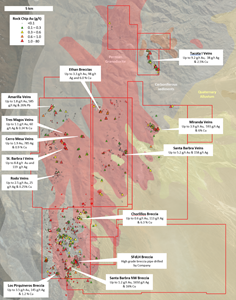
Recent exploration has focused on mapping and sampling new acquisitions to the north of our original holdings. This exploration has identified numerous mineralised vein and breccia systems with surface grades comparable to those found on the surface of the SFdLA breccia pipe.
Figure 2 – Current progress of soil survey in the Santa Barbra 1 licence
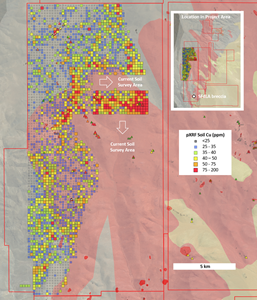
The licence is located to the north of the Companies original holdings, with recent exploration identifying numerous vein and breccias systems. To date over 3200 soil samples have been obtained on a 100m grid, with initial analysis by portable XRF (pXRF) defining several large geochemical anomalies that will received detailed follow up exploration.
Figure 3 – The Tacota vein system
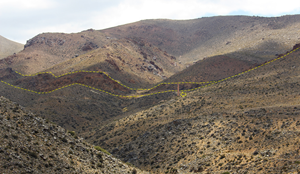
A series of quartz-tourmaline-sulphide veins hosted in a 10 to 100m wide zone of brecciated sediments (dashed line) that extends for over 1 km in strike length. Sampling of this zone has returned assays of up to 9.2 g/t Au, 38 g/t Ag and 0.5 % Cu. Arrow points to chimney of smelter at historic mine.
Figure 4 – Typical mineralisation at the Miranda vein system
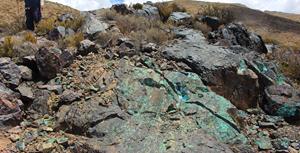
Miranda consists of three parallel quartz-tourmaline-sulphide vein arrays that are up to 8 m wide with strike lengths of 900 to 1600m. Rock chips from the veins have returned assays of up to 3.9 g/t Au, 593 g/t Ag and 6.0 % Cu.
Figure 5 – Typical mineralisation at the Ethan breccia system
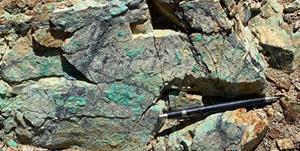
At Ethan a 100m diameter tourmaline breccia pipe is surrounded by a broad halo of tourmaline-sulphide veinlets (shown). Sampling at the prospect has returned rock chip assays of up to 3.3 g/t Au, 23 g/t Ag and 5.2 % Cu. The geology and grades at Ethan are similar to what is seen at the surface of the high-grade SFdLA breccia pipe.
Figure 6 – Sheeted quartz veins at Cerro Mesa
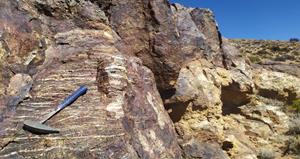
At Cero Mesa layers of sub-horizontal sheeted quartz veins several metres thick alternate with layers of tourmaline breccia over a 150 by 250 m area. Sampling at the prospect has returned rock chip assays of up to 1.9 g/t Au, 785 g/t Ag and 1.1 % Cu.
2021 GlobeNewswire, Inc., source

